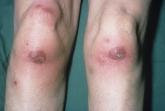News

Precision medicine: A new approach to AML, other blood cancers
- Author:
- Caleb Rans
- PharmD
Precision medicine makes groundbreaking strides in treating myeloid malignancies by integrating individual molecular data into patient care.
News
Study supports changing classification of renal cell carcinoma
- Author:
- Caleb Rans
Survival data support reclassifying stage III node-positive renal cell carcinoma as stage IV disease.
News
Preoperative nivo/ipi yields high response rate in early-stage colon cancer
- Author:
- Caleb Rans
Pathological responses occurred in 100% of patients with mismatch repair-deficient tumors.
News
Guidelines for radiotherapy in prostate cancer during the pandemic
- Author:
- Caleb Rans
The experts recommend avoiding, deferring, or shortening radiotherapy whenever possible.
News
CNS cancer outcomes worse for black and Hispanic children
- Author:
- Caleb Rans
Black and Hispanic patients younger than 19 years have a higher risk of death from central nervous system cancers.
News
Combo maintenance boosts PFS, not OS, in advanced NSCLC
- Author:
- Caleb Rans
Adding pemetrexed to bevacizumab maintenance improved progression-free survival but not overall survival.
News
Antidepressant could treat recurrent prostate cancer
- Author:
- Caleb Rans
A quarter of patients achieved a PSA reduction of at least 30% from baseline, and 10% had a reduction of at least 50% from baseline.
News
HRQOL deteriorates after disease progression in metastatic cancer
- Author:
- Caleb Rans
The association between progression and global HRQOL was of greatest magnitude in lung and pancreatic cancer.
News
Colorectal cancer burden rises in younger age groups
- Author:
- Caleb Rans
The incidence of colorectal cancer is on the rise in people aged 50-64 years and in those younger than 50 years...
News
Bevacizumab/pembrolizumab deemed safe and active in mRCC
- Author:
- Caleb Rans
The combination produced responses in 42% of relapsed/refractory patients and 61% of previously untreated patients.
News
Combined biopsy method improves diagnostic accuracy in prostate cancer
- Author:
- Caleb Rans
Combining MRI-targeted and systematic biopsy resulted in 9.9% more prostate cancer diagnoses.
News
CLTX-CAR T cells exhibit preclinical activity and move on to a clinical trial
- Author:
- Caleb Rans
Following positive preclinical results, chlorotoxin-directed CAR T cells will be evaluated in a clinical trial...
News
Preoperative chemoradiotherapy failed to boost overall survival in pancreatic cancer
- Author:
- Caleb Rans
Preoperative chemoradiotherapy did not improve overall survival but did improve disease-free survival and other endpoints.
News

HLA-B27 status predicts radiographic phenotype of axSpA
- Author:
- Caleb Rans
Study findings from ankylosing spondylitis and axial psoriatic arthritis patients emphasize “the importance of HLA-B27 status in severity and the...
News
Death from unintentional injury is higher in cancer patients
- Author:
- Caleb Rans
More initiatives are needed to help recognize patients at risk of death from unintentional injury, according to researchers.
